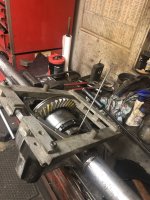I don't think there is anything wrong with 31 spline axles for most people in the 33" tire range. Some people have a talent of breaking every mechanical thing they touch and need beefier and beefier parts. But for most non-abusive (or only mildly abusive) use the 31 spline axles have all the beef needed.
If starting with all new parts, 35 spline is nice and for the most part only costs a few dollars for the upgrade. But with an already good center section in 31 spline, run it. There are plenty of other driveline parts that will fail before a 31 spline axle will be an issue.
I do not make the rule. The 31 spline axle has proven itself to be necessary and barely adequate in passenger cars. As I indicated before, the Mopar B and E body passenger car runs on F60-15 tires which are 26.27 inches in diameter, and got 1.5 inch 35 spline axles and a power lock. That axle has become legendary.
The front drive axle on a 1978 3/4 ton F250 club cab with snow fighter got you the 1.5 inch 35 spline axles. But the rear axle got you the puny 1-5/16-30 spline. (same idiot engineer in the drive train division.) This front axle is known as the King Pin 60 Sno-fighter and is also legendary.
The 31 spline axle is used on Ford Explorers with 28.8 inch tires and a really crappy traction lock. Every full size passenger car and 1/2 ton pickup and van ended up with the 31 spline 9 inch. The only one that had a decent traction adding device in it was the very rare 69-70 Boss and Cobra Jet Nodular 9 inch with Detroit no-spin. It was perfectly adequate in race car situations with equal traction between tires, and could handle 30 x 10.50 x15 street slicks.
Every Ford 3/4 ton pickup built after 1985 received a Sterling rear axle with 1.5 inch shafts. Every single 3/4 ton Chevy pickup built after 1972 With the 14bolt got 1-9/16 x 30 splines. Every Dodge with a Cummins got 1.5 inch shafts. All legendary.
The Ford 9 inch is the outlier. It was used in high performance cars, and in Stock Cars for decades as the standard. It has become legendary. But its legend is built on a false premise. The Ford 9 inch can be made to be extremely strong, and durable. But it usually isn't. Aftermarket companies like Strange, Mark Williams, Currie, True Hi-9 and others have worked to make the 9 inch into what it has become. But it ain't STOCK.
The biggest thing that people (and designers) neglect is the vast increase in torque on a single axle with a positive locking differential. It changes everything. It is the reason why some people will tell you that the Dana 30 can handle 35's all day long, and others will tell you that a Dana 44 can't handle 33's. As soon as you throw in a locker, you have the real world potential for 100% torque on a single shaft. This NEVER happens on the race track, or on the street. Fact is...99% of all applications work just fine with an open diff. And for that last 1%...a torque bias of about 20% is all you ever need. So a crappy, cheap, unreliable clutch type posi is all most people get. Once you throw in a locker, and you USE it, the axle shafts see tremendous load, and they fail. Then they grow.
This is why you see 1/4 ton Jeep TJ's on the trail running rear 7.5 and 8 inch ring gears...with 1.5 inch 35 spline shafts. But those same shafts in a full size get an 11.5 inch ring gear.
But I totally agree. If you leave your Bronco on the trailer...the 31 spline shafts seem to hold up just fine. And I agree with
@Yeller on the build vs buy thing. It's awfully convenient to click on an item and put it in your cart. then a few weeks later, a truck shows up with a bolt in axle that will work perfectly.
But it's also kinda fun to find a used GM 14 bolt from a M1009 CUCV with 4.56 gears and a factory Detroit Locker and bolt it into your Bronco for $500.



















